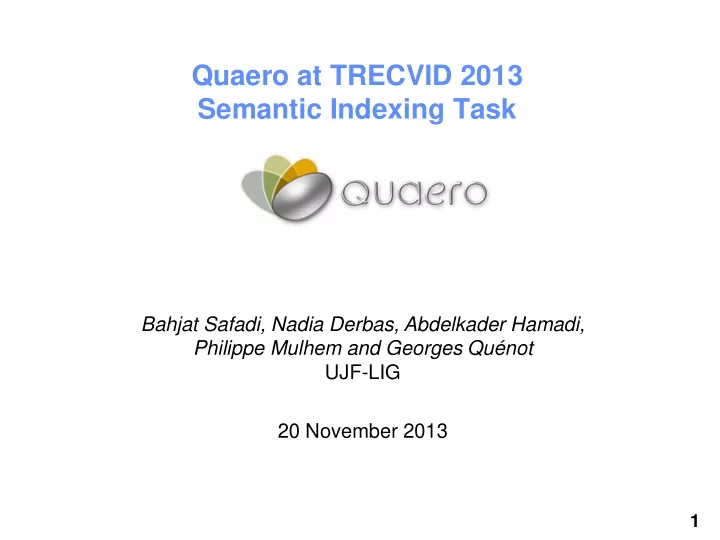

Quaero at TRECVID 2013 Semantic Indexing Task Bahjat Safadi, Nadia Derbas, Abdelkader Hamadi, Philippe Mulhem and Georges Quénot UJF-LIG 20 November 2013 1
Outline • Main task: almost nothing new – Use of semantic features: +8% relative gain – Result used for the pair and localization tasks • Pair task: – Can we beat the baseline? • Localization task: – Can we do it without local annotations? 2
The Quaero classification pipeline Text Audio Image Descriptor extraction Descriptor transformation Conceptual feedback Classification Descriptors and classifier variants fusion Higher level hierarchical fusion Re-ranking (re-scoring) Classification score 3
Main task • As in 2011 and 2012 (see TV11 slides) - Six-stage pipeline including temporal re-ranking (actually re-scoring) and conceptual feedback - Use of a large number of descriptors shared by the IRIM group from GDR ISIS • New descriptor: - Vectors of 1K and 10K concepts scores trained on ILSVRC10 and ImageNet and applied to key frames, kindly produced by Florent Perronnin from Xerox (XRCE) - Excellent individual descriptor (infAP of 0.2291, late fusion of both 1K and 10K versions) - Complementary to other descriptors: relative gain of 8% before conceptual feedback and temporal re-ranking (from 0.2387 to 0.2576; 0.2848 after feedback and re-scoring). 4
Category A results (Main runs) Median = 0.128 0.2835 All with one iteration of feedback 0.2848 All with two iteration of feedback 0.2846 All with two iteration of feedback + uploader weak (bug) 0.2827 All with two iteration of feedback + uploader strong (bug) Differences not statistically significant 5
Concept pairs: can we beat the baseline? • Which baseline? • Single concept scores approximately calibrated as probabilities (e.g. Platt’s method) • Sum or product (arithmetic of geometric mean) or minimum of the single concept scores • Best (worst) individual classifier performance • Most (least) frequent single concept • What alternatives? • Direct learning: very imbalanced, extremely few positive samples, but possible for most pairs • Other and possibly more complex methods for single concept score fusion 6
Category A results (Concept Pairs) Median = 0.1125 Baseline + two-step ranking + learning Baseline Baseline + two-step ranking Quaero official submissions on concept pair: • Not using the final version of single concept scores (late) • Two-step ranking: ranking the top list of one concept with the ranking of the other + symmetrization, not so goof idea • Direct learning incomplete relative to the concept learning • Not bad but not significant results 7
“Baselines” from best Quaero submission (NOT official submissions) • Use of one of the two scores: - Most frequent (dev): 0.1096 - Least frequent (dev) : 0.1130 - Higher infAP (CV): 0.1222 - Lower infAP (CV) : 0.1004 • Use of both scores: - Sum (arithmetic mean): 0.1613 - infAP weighted sum (CV): 0.1613 - infAP weighted sum with power (CV): 0.1637 - Product (geometric mean): 0.1761 (makes sense) • Best official submission (UvA): 0.1616 8
Alternatives (non official values) • Rank fusion: arithmetic mean of shot ranks • Boolean fusion (extended Boolean approach [9]): • Direct learning: handle imbalance with MSVM 9
By concept pair results • Rank fusion is the best, very close to product fusion • But: most of the MAP is supported by only two concepts • Almost no difference is statistically significant 10
Localization task: Can we do it without local annotations? Motivation: • Annotations are costly and boring • Local annotations are even more • We had no time and support to do any 11
Localization task proposed approach Inspired from (Ries and R. Lienhart, 2012): • Compute local descriptors (opponent SIFT fro UvA tool) • Cluster local descriptors (k-means) • Learn discriminative models for clusters based on relative occurrence frequencies using global image annotations only • Filter points in a an image predicted as globally positive • Select a rectangle according to the density of points using horizontal and vertical projections • Main problem: - no training data for parameter tuning (e.g. threshold selection); C. X. Ries and R. Lienhart. Deriving a discriminative color model for a given object class from weakly labeled training data. In Proceedings of the 2nd ACM International Conference on Multimedia Retrieval, page 44. ACM, 2012. 12
Localization task proposed approach 13
Filtering SIFT points • Relative Occurrence Frequency (ROF): ROF p (y) = p y /p and ROF n (y) = n y /n with: p y (resp. n y ) = number of positive (resp. negative) images in which at least one point belonging to the cluster y is present in the image and: p (resp. n) = total number of positive and negative images • Filter a point associated to a cluster y according to ROF p (y)/ROF n (y) or simply to ROF p (y) (better) 14
Finding Rectangles • Compute horizontal and vertical histograms of filtered points (32 bins for each projection) • Remove bins from left and right (resp. top and bottom) as long as the bin value is below a given threshold β • Keep the rectangle covering the remaining bins • β is manually tuned separately for each concept by looking at the top 500 results within the development set (human intervention but not exactly annotation) • Limitation: approach suited for finding a single rectangle 15
Sample results (1) 16
Sample results (2) 17
Only one submitted run • Quite good in temporal detection but mostly comes from the concept detector developed for the main task • Less good for the spatial localization but not so bad • The recall versus precision compromise was not optimized • No region annotation was used • Many possible improvement • TV13 assessment will allow a better tuning for next issues or other applications 18
Thanks 19
Recommend
More recommend